KOLLEKTIVNYE DEYSTVIYA (COLLECTIVE ACTIONS). DESCRIPTIONS OF THE ACTIONS
JOURNEYS TO THE COUNTRYSIDE. VOLUME THREE
31. MUSIC WITHIN AND OUTSIDE
For a week’s time I was meditating on action titled "Towers". I cut out images of towers in various magazines and pasted them on white paper, accompanied with a tower’s description, estimated a 30-minutes long taxi ride. But then it suddenly came to me that the job was not worth the effort. However, on the 7th of April I decided to record the sound of trams passing by, which were necessary for the "Towers" action. About midnight I and Sorokin went to the boulevard along Koroleva street, and I did what was needed. On the next day I was certain to cancel the action. I did not even listen to the record made on the boulevard. Two days later N came to me. We had a nice time together, and all of a sudden I felt an urge to listen to the record with trams. It turned out to be splendid. I had a stereo recorder, so the effect was dimensional: first a distant sound of an accelerating tram appears in the right ear, then it thunders by in the center of my head, and finally fades away in the left ear. I devised a plan of an action titled "Trams are remainsof towers": Romashko with a turned-on Walkman stands on pavement, facing the boulevard where trams run, and listens to my record for 30 minutes. It only consists of noises of trams passing by. In the end of this record there is an instruction for Romashko prompting him to describe in a few words the sound environment in which he was perceiving the trams passing by.
I offered N. (it was about an hour before midnight) to go outside and make the necessary record. I switched the lights off in the room to go and get clothed. But then we started to fool around, lied down in darkness, hugged and kissed… Finally we didn’t go anywhere.
We got up at 8 in the morning, and I turned on Nina Hagen’s record "Angstlos" to make a boost – there were a couple of nice tracks, although in my opinion this particular record was less interesting compared to her previous ones. By the way, I was writing a short text the other day, concerning aesthetical estimations and judgments. As far as I remember, I stated that there were no prosperity and decline in art, but rather "distances" and "depths". After listening to this record, I became uncertain about my own judgment, as it was too much like "decline", rather than "depth". Later, on the day of our wedding with N., I listened to some pieces of key musical compositionsof the seventies: Klaus Schultze, Glass, Cage, Stockhausen, and then to the most fashionable songs of the eighties. Alas, I’d better not done that! With all my openness and sincere interest for anything really new, the comparison (in my own humble point of view, of course) was certainly not in the favor of the 80s.
Then we had breakfast and listened to The Residents’ record: a fine piece of afro-infantile music. And finally, only after listening to one side of Steve Reich’s "Music for 18 musicians", the word "REMAINING" crossed my mind. I went to see N off at a trolley bus stop around noon. We crossed the street railway where I had planning the action "Trams are remainsof towers", randomly chose a tree by which Romashko was to be standing. All the way through I was pointing at some passer-by and telling N.: "look there, a REMAINING one passes by!". What exactly that meant and why that particular word occurred to me at all, I was not sure. It probably was some kind of syndrome.
When we approached the trolley bus stop, an elderly woman arrested our attention, most probably a rural type. She had two bags in her hands. She stopped by a tree near us, produced two packs of cocoa powder from her bag and put it on the ground beside the tree. Then she looked at us and said: "I don’t want this cocoa, it was given to me as part of a holiday food ration, but I don’t want it. Take it, or let it REMAIN here". We started to persuade her not to REMAIN the cocoa, but she seemed determined. She kept telling us that she was going to leave it where it was. Suddenly, somebody fell over on asphalt by another tree. I turned my head and saw protruding legs and a body hidden behind the tree. I came up and noticed a man lying on the ground in dirty overcoat and beside him a string bag with two bottles of vermouth. It took me quite an effort to get him standing. As I got him under his arms, he grabbed my sleeve and said: "Let me show you something". He produced a wallet from his pocket and showed me first a badge of a "Merited Kremlin servant", then a labor veteran’s credentials. He asked me to focus my attention on the signature of the person who issued the certificate. As far as I remember, it was some kind of a KGB officer, his surname was Aldanov. The man muttered that he had been under Lavrenty Beriya’s command. Certainly, the poor crook was positively a remaining one. While I was trying to get him off my back, the woman with cocoa disappeared – perhaps she made up her mind not to let it REMAIN. Then a trolley bus came up, N. departed and I went homewards.
I spent the next few days devising the content of the future record, which was already thought of as more a musical piece to be listened to by anyone, rather than an action. The only two conditions that determined the audition of the record were that it was to be listened only from 23:00 to half an hour before midnight and only at a certain location where it had been made. The record itself was to consist primarily of tram noises – that means that we were to come to the location, turn on the recorder in recording mode and tape the sounds of trams passing by. Additionally, we intended to use some musical instruments to sound at a certain distance from the recorder. First of all, we thought of a French horn and oboe to be played by S.Letov (hereby we utilize the peculiar feature of "Letov’s tails" which was once planned for the action "Music of the Center", but failed to put it into practice. Its nature is the following: Letov starts playing his instrument while a tram passes by and keeps sounding for a minute or two after it has already passed by the recorder. In "Music of the Centre" there was train instead of trams. Therefore, the recording is expected to contain a kind of acoustic traces, or tails – transport noises transform into musical tone). Secondly, we use a drum, N. Panitkov’s Buddhist ritual shell, a couple of bells, ringing of an alarm clock, a Chinese mouth harmonica and sometimes various vocal sonoristics.
But these things are secondary on the record, its primary content is the sound of trams passing by, while musical instruments are only embedded from time to time. Therefore, we were to record a soundtrack for "Music Within and Outside" – it seemed a fine name for this piece. A viewer’s visual attention could be focused on passing trams, anticipation of them, watching them run etc. At this point some peculiar coincidences could occur of recorded trams with real ones passing by.
Today, on the 20th of April, we made an arrangement with Letov and Panitkov to record the soundtrack. I called Kizewalter and asked him to photograph the process. But he refused, saying that this was too boring and expressed the wish to abandon Collective Actions group. Well, it was a pity, but that’s the ball game. Kizewalter followed Nikita Alexeev and became an independent artist. We could only wish him success. So we were left alone with Panitkov, Makar with Lena and Romashko.
***
Yesterday from 22:40 to 23:10 we were recording "Music Within and Outside" – Letov, Panitkov, L. Romanova and me. Besides that, Alik Sidorov happened around with a flash camera. He pictured us outside in the course of recording (more accurately, before the recording, as we did the taping without him). The process underwent quite well, to my opinion. In the center there was either silence or noises of a tram passing by, on the margins strange distant, muted musical sounds. We used a French horn (Letov and me), a Buddhist shell (Kolya), a drum, bells, an alarm clock, a whistle, voice (me). After the recording we called on my place and listened to it. By the way, we were afraid that militia could get us into trouble. Nothing of the sort happened, and the strongest feeling of relief came not from the improvisation itself, but rather because everything went smoothly and nobody made any difficulties.
I think that a "daytime brushstroke" of tram noises would fit almost perfectly in the middle of the recording. I thought of recording on the same location the approaching, passing by the recorder and the recession of a tram, daytime or maybe in the morning. Right now I am heading to museum (today is 21st of April, the subbotnik [a day of voluntary unpaid labor], and also my wedding with N scheduled for 5 p.m.) and while walking along the road I shall try to cue in that "brushstroke". No, after second listening to the record, I made up my mind not to include the "brushstroke", not to spoil its homogeneity, its authentic nature. A very interesting thing to listen to is Kolya’s shell – as if some kind of a jungle beast croaking, hissing, groaning at cars and trams passing by.
***
Thus, yesterday (22nd of April, 1984) S. Romashko listened to the record of "Music Within and Outside". The audition started at the location of recording – on Korolyeva street where tram lines 7 and 11 drive by – at 22:40 and finished at 23:10. It was noticeably cold, just a few points above zero. But, as Romashko said, the level of comfort was quite satisfactory. At his estimation, the thing was well-conditioned. Me and N., while taking a stroll nearby, reckoned a total of 7 trams having passed by Romashko in both directions. On the records there are some more. After the audition we returned to my apartment, and Romashko voiced a short story about today’s events to tape recorder. I shall transcribe it later and include it to the documentation. Kizewalter’s case, by the way, resolved quite peacefully. I called him, and he agreed to photograph the auditioning, and did so. However, it is not clear whether anything came off or not: he photographed Romashko using flash upon the background of an illuminated tram passing by. I understand Goga’s frequent discontent against me. But, after all, it is more reasonable to ignore trivial psychological inconveniences and keep "Collective Actions" together in previous membership. Our performances are not very frequent, and they don’t demand too much effort.
Yesterday I and N. took a ride on tram 11 to Sokolniki and had a nice stroll in the park. We walked past Malenkovsky lakes, watched an athlete enjoy his bathing in ice-cold water. In the end of the walk a rare scene touched me. Nearby the park’s exit a group of elderly, slightly drunk people in rather dirty, shabby overcoats danced ecstatically to bravura sounds of a small orchestra. At closer inspection, the spectacle turned out to be even more moving, as these prostitutes and drunkards danced absolutely alone, exposed to wind and cold, on a broad deserted asphalt square. We stood and watched them for some fifteen minutes, then left the scene while they kept on dancing with the same energy and delight.
A.M.
Moscow
20th of March – 20th of April – 22nd of April, 1984
A. Monastyrski, N. Panitkov, S. Letov, G. Kizewalter, E. Romanova, S. Romashko
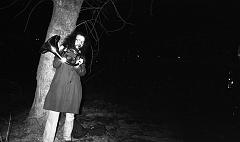 |
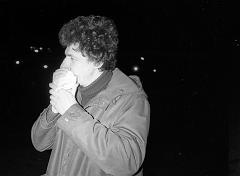 |
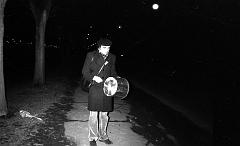 |
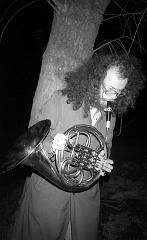 |
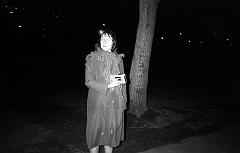 |
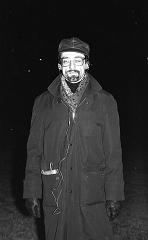 |
